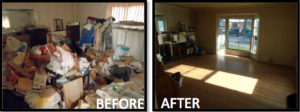
Hoarding continues to sweep the US in record numbers. Hoarding affects up to 6% of the US population which is approximately 19 million people, twice the rate of OCD. Hoarding has been found to run in families and is quickly emerging as an issue that continues to grow as the population ages. Hoarding tendencies typically get worse as one ages and usually after the death of a loved one, a divorce, or another significant crisis or traumatic incident.
Hoarding is a mental health condition that is now diagnosable on its own, listed in the DSM, and no longer diagnosed as OCD. Awareness around hoarding is increasing but still remains an underdiagnosed and undertreated mental illness. To put it into greater perspective, Hoarding is six times more prevalent than Autism but is not as well known, researched, or funded.
Compulsive hoarding is associated in various studies with serious health risks such as household falls, obesity, respiratory problems (caused by dust mites, rodent feces, and squalor), and poor medication compliance not to mention the risk of falling over the debris. For a better understanding of hoarding and how a hoarder feels take a look at this video by Psychologist Dr. Greg Chasson of Towson University who outlines the symptoms of compulsive hoarding and how it can lead to debilitating stress. (Towson University)
Call Bio SoCal if you or a family member needs help and we can discuss your specific situation and schedule a FREE in-home estimate.

